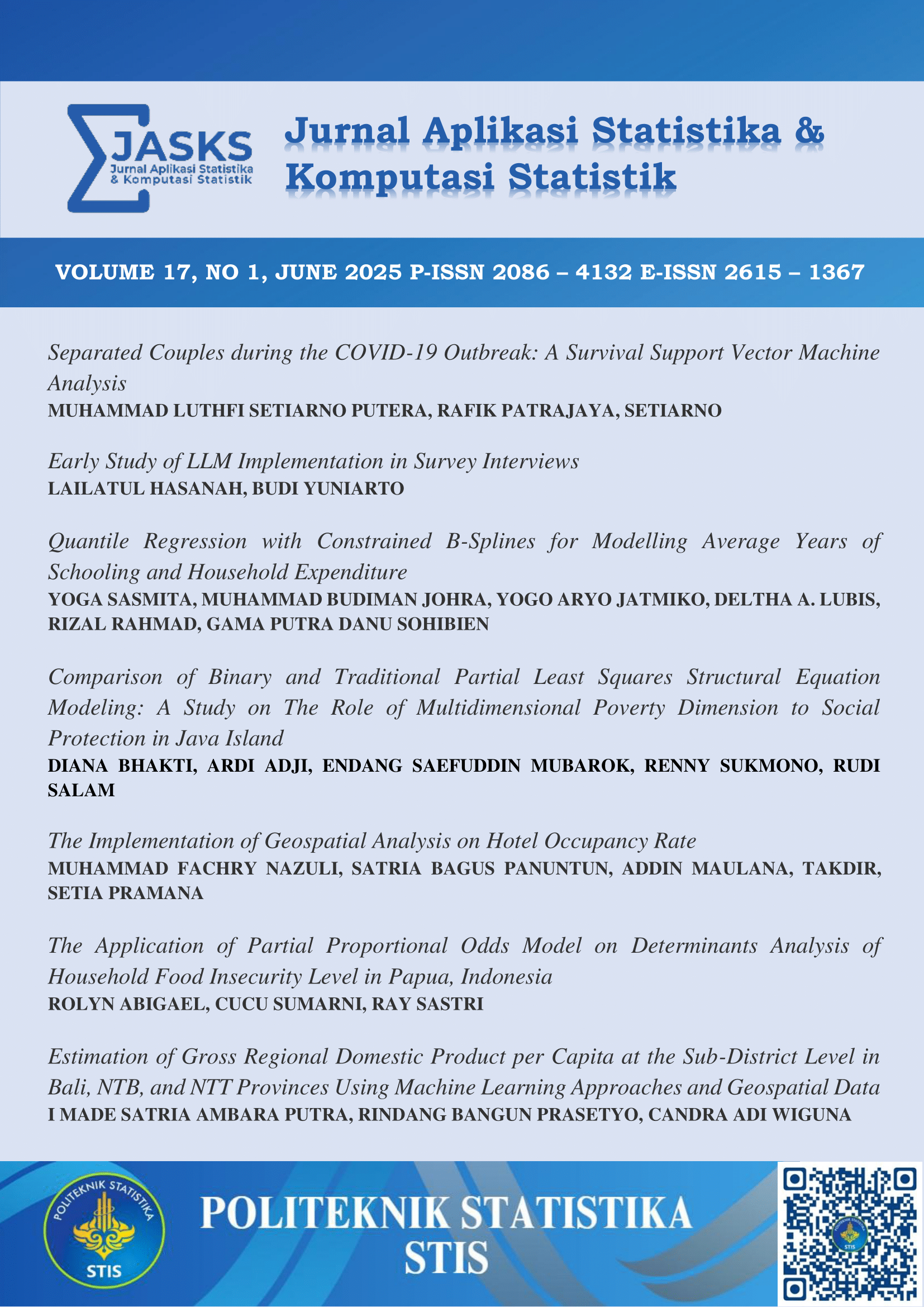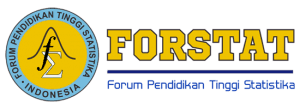The Application of Partial Proportional Odds Model on Determinants Analysis of Household Food Insecurity Level in Papua, Indonesia
DOI:
https://doi.org/10.34123/jurnalasks.v17i1.798Keywords:
Food Insecurity, Logistic Regression, Ordinal Response Model, Parallel Lines Assumption Violation, Partial Proportional OddsAbstract
Introduction/Main Objectives: Food insecurity in Papua, Indonesia, is still high. However, the study on that issue is limited. This research aims to analyze the determinants of food insecurity in Papua. Background Problems: An ordinal logistic regression can be used. However, this model generally requires the parallel lines assumption. However, somehow, the assumption is often violated. Novelty: This study used a model that relaxes the assumption of parallel lines. This model can capture the condition that some parameters are assumed to meet parallel lines and some do not. Research Methods: In this case, the partial proportional odds model was applied to find the determinant of household food insecurity status by using the National Socioeconomic Survey (SUSENAS) data. Finding/Results: The results show that a female head of household, age 60 years and above, junior high school education and below, has a higher tendency to be at least mildly food insecure, and the effect is the same for each level of food insecurity. Household heads who do not work, work in agriculture, and have household drinking water sources that are not feasible can aggravate the food insecurity level. Meanwhile, food assistance provided by the government influences reducing food insecurity levels.
Downloads
References
BAPPENAS- Pilar Pembangunan Sosial Metadata Indikator Tujuan Pembangunan Berkelanjutan Indonesia [Indonesian National Development Planning Agency, Pillars of Social Development Metadata Indicators of Sustainable Development Goals of Indonesia], Jakarta: Deputy for Maritime Affairs and Natural Resources, Indonesian National Development Planning Agency, 2023.
BPN- Indeks Ketahanan Pangan [Food Security Index], Jakarta: Deputy for Food and Nutrition Vulnerability, National Food Agency, 2022.
BPN- Food Security and Vulnerability Atlas (FSVA) 2022, Jakarta: Deputy for Food and Nutrition Vulnerability, National Food Agency, 2022.
J.L. Leroy, M. Ruel, E.A. Frongillo, J. Harris, and T.J. Ballard. “Measuring the food access dimension of food security: A critical review and mapping of indicators,” Food Nutr. Bull., vol. 36, no. 2, pp. 167–195, 2015, doi: 10.1177/0379572115587274.
A. W. Borku, A. U. Utallo, and T. T. Tora, “The Level of Food Insecurity among Urban Households in Southern Ethiopia: A Multi-Index-Based Assesment,” Build. Environ., p. 107386, 2020, doi: 10.1016/j.jafr.2024.101019.
S. Ndhleve et al., “Household food insecurity status and determinants: The case of botswana and south africa,” Agraris, vol. 7, no. 2, pp. 207–224, 2021, doi: 10.18196/agraris.v7i2.11451.
M. D. Smith, W. Kassa, and P. Winters, “Assessing food insecurity in Latin America and the Caribbean using FAO’s Food Insecurity Experience Scale,” Food Policy, vol. 71, pp. 48–61, 2017, doi: 10.1016/j.foodpol.2017.07.005.
E. Grimaccia and A. Naccarato, “Food Insecurity in Europe: A Gender Perspective,” Soc. Indic. Res., vol. 161, no. 2–3, pp. 649–667, 2022, doi: 10.1007/s11205-020-02387-8.
O. B. Sheikomar, W. Dean, H. Ghattas, and N. R. Sahyoun, “Validity of the Food Insecurity Experience Scale (FIES) for Use in League of Arab States (LAS) and Characteristics of Food Insecure Individuals by the Human Development Index (HDI),” Curr. Dev. Nutr., vol. 5, no. 4, pp. 1–10, 2021, doi: 10.1093/cdn/nzab017.
E. Ari and Z. Yildiz, “Paralel Lines Assumption in Ordinal Logistic Regression and Analysis Approaches,” Int. Interdiscip. J. Sci. Res., vol. 1, no. 3, pp. 8–23, 2014.
A. Agresti, Categorical Data Analysis Third Edition, New Jersey: John Wiley & Sons, Inc., 2013.
D. W. Hosmer, S. L. Jr., and R. X. Sturdivant, Applied Logistic Regression.3rd Edition, New Jersey: John Wiley & Sons, Inc., 2013.
A. Agresti, An Introduction to Categorical Data Analysis Second Edition, New Jersey: John Wiley & Sons, Inc., 2007.
D. G. Kleinbaum and M. Klein, Logistic Regression: A Self Learning Text, New York: Springer, 2010. doi: 10.1007/978-1-4419-1742-3.
A. Agresti, Analysis of Ordinal Categorical Data Second Edition, New Jersey: John Wiley & Sons, Inc., 2010.
R. Azen and C. M. Walker, Categorical Data Analysis for the Behavioral and Social Sciences. New York: Taylor and Francis, 2011.
S. Parry, “Ordinal Logistic Regression models and Statistical Software?: What you need to know,” Cornell Statistical Consulting Unit Stat News #91, 2020.
R. Williams, “Generalized ordered logit/partial proportional odds models for ordinal dependent variables,” Stata J., vol. 6, no. 1, pp. 58–82, 2006, doi: 10.1177/1536867x0600600104.
A. Nigusu and M. Shewadinber, “The status and determinants of rural household food insecurity in North Shewa Zone, Oromia Region, Ethiopia,” Turkish J. Food Agric. Sci., vol. 4, no. 1, pp. 6–12, 2022, doi: 10.53663/turjfas.1020187.
G. G. Gebre, “Determinants of Food Insecurity among Households in Addis Ababa City, Ethiopia,” Interdiscip. Descr. Complex Syst., vol. 10, no. 2, pp. 159–173, 2012, doi: 10.7906/indecs.10.2.9.
T. Sekhampu, “Determination Of The Factors Affecting The Food Security Status Of Households In Bophelong, South Africa,” Int. Bus. Econ. Res. J., vol. 12, no. 5, p. 543, 2013, doi: 10.19030/iber.v12i5.7829.
T. Birhane, S. Solomon, S. Hagos, and S. M. Katia, “Urban food insecurity in the context of high food prices: a community based cross sectional study in Addis Ababa, Ethiopia,” BMC Public Health, vol. 14, pp. 1–8, 2014, [Online]. Available: http://www.embase.com/search/results?subaction=viewrecord&from=export&id=L605376010%0Ahttp://dx.doi.org/10.1186/1471-2458-14-680
N. F. Ruhyana, W. Y. Essa, and Mardianis, “Sociodemographic factors affecting household food security in Sumedang regency West Java province,” Agraris, vol. 6, no. 1, pp. 38–51, 2020, doi: 10.18196/agr.6189.
D. Etana and D. Tolossa, “Unemployment and Food Insecurity in Urban Ethiopia,” African Dev. Rev., vol. 29, no. 1, pp. 56–68, 2017, doi: 10.1111/1467-8268.12238.
S. Sophia, E. Erwandri, R. Dewi, and F. Varina, “Analisis Tingkat Ketahanan Pangan Keluarga Penerima Manfaat Bantuan Sosial Pangan (Kpm Bansos Pangan) di Kabupaten Batang Hari [Analysis of Food Security Level of Families Receiving Food Social Assistance in Batang Hari Regency],” JAS (Jurnal Agri Sains), vol. 6, no. 2, pp. 113–121, 2022, doi: 10.36355/jas.v6i2.920.
A. Azwardi, H. F. Widyasthika, R. C. Saleh, and N. Adnan, “Household Food Security: Evidence From South Sumatera,” Jejak, vol. 12, no. 2, pp. 446–465, 2019, doi: 10.15294/jejak.v12i2.20264.
E. R. Amrullah, A. Pullaila, I. Hidayah, and A. Rusyiana, “Dampak Bantuan Langsung Tunai Terhadap Ketahanan Pangan Rumah Tangga Di Indonesia [Impacts of Direct Cash Transfer on Household Food Security in Indonesia]," J. Agro Ekon., vol. 38, no. 2, pp. 77–90, 2020, doi: 10.21082/jae.v38n1.2020.77-90















